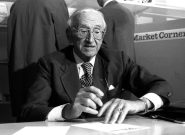Hayek was an originalist of a certain sort, one who favored an original meaning based on the words of the Constitution and the enactors' intent.
Who are Officers of the United States? The Inadequacy of the Buckley Standard
Jennifer Mascott gave a talk at the University of San Diego Originalism Center on her new paper, which is to be published in the Stanford Law Review, on Who are the Officers of the United States?
The paper engages in originalist research on an important topic that modern originalist scholars have largely neglected: how to distinguish between officers, who are subject to the Appointments Clause procedures, and employees, who are not. Mascott concludes that many more government positions constitute offices than modern law allows and therefore are subject to the requirements of the Constitution’s Appointments Clause.
For many years, the question of who is an officer of the United States has been answered based on the standard announced in Buckley v. Valeo — a person who exercises significant authority pursuant to the laws of the United States. The significant authority standard has been applied by looking to the importance of the position, to whether the person exercises significant discretion, and whether the person exercises the sovereign authority of the United States.
But people tend to forget that the Buckley v. Valeo standard, while intuitive, was not based on originalist research. Part of the reason for this is that the narrow result in Buckley no doubt was a strong step in the originalist direction. In Buckley, the Congress had established a Federal Election Commission, for which the commissioners were not appointed in accordance with the Appointments Clause. Two commissioners were appointed by the House, two by the Senate, and two by the President, with all six commissioners subject to confirmation by both the House and Senate. The Supreme Court held that all six members were officers of the United States, who had to be appointed in accord with the Appointments Clause. Clearly, the heads of an agency, like the commissioners, were Officers of the United States under any plausible view of the Appointments Clause.
One question is how the Congress concluded that it could get away with such a blatantly unconstitutional commission? The likely answer is that it the law was passed in 1974. The Supreme Court had stopped enforcing the separation of powers against laws enacted by Congress during the New Deal and so Congress believed that anything would go. But the Court in Buckley announced to the world that the Separation of Powers would start to be enforced. In that respect, Buckley seemed like an obviously good and originalist decision.
But merely because Buckley got the right originalist result does not mean its analysis was correct. So the question remains – which Mascott’s paper addresses – what is the dividing line between officers and nonofficers?

